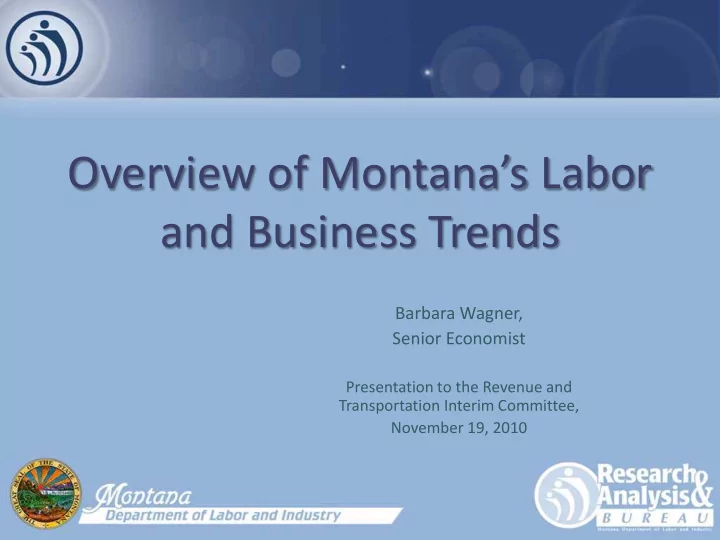

Overview of Montana’s Labor and Business Trends Barbara Wagner, Senior Economist Presentation to the Revenue and Transportation Interim Committee, November 19, 2010
Personal Income Growth by Quarter, U.S. and MT 2.5% 2.0% 1.5% 1.0% 0.5% 0.0% -0.5% -1.0% -1.5% -2.0% -2.5% US Montana
U.S. and MT Unemployment Rates Since 2000 12.0 1 Recession MT US 10.0 8.0 6.0 4.0 2.0 0.0 0 2000 2001 2002 2003 2004 2005 2006 2007 2008 2009 2010 Source: Bureau of Labor Statistics, Current Population Survey and Local Area Unemployment Statistics.
Indexed U.S. and MT Payroll Employment Employment in Dec. 2007= 100% 102.0% 100.0% 98.0% 96.0% 94.0% MT US 92.0% 90.0% Jan-07 Mar-07 May-07 Jul-07 Sep-07 Nov-07 Jan-08 Mar-08 May-08 Jul-08 Sep-08 Nov-08 Jan-09 Mar-09 May-09 Jul-09 Sep-09 Nov-09 Jan-10 Mar-10 May-10 Jul-10 Sep-10 Source: Current Employment Statistics, Seasonally Adjusted.
The Whys of a Jobless Recovery 1. Employment lags an economic recovery 2. Increases in labor productivity 3. Structural unemployment 4. Business uncertainty is delaying hiring
Employment Loss and Duration, U.S. vs. MT Last Three Recessions US MT Official Percent Loss of Months until Percent Loss of Months until Duration of Employment, Employment Employment, Employment Recession in Peak to Trough Recovered Peak to Trough Recovered Months 1990 8 1.5% 32 1.0% 4 2001 8 2.0% 48 0.5% 10 2007 18 6.1% 34 and 5.8% 30 and counting counting
Income Growth has not Resulted in Job Growth Because of Labor Productivity 115 110 105 100 95 Output Per Hour Output 90 Hours Worked 85 1 2 3 4 1 2 3 4 1 2 3 4 1 2 3 4 1 2 3 4 1 2 3 2005 2006 2007 2008 2009 2010 Source: Bureau of Labor Statistics, Quarterly Labor Productivity for the U.S.
Income Growth has not Resulted in Job Growth Because of Structural Unemployment U.S. Employment and Job Openings 5,500 140,000 138,000 5,000 136,000 4,500 134,000 4,000 132,000 3,500 130,000 Job Openings 3,000 128,000 2,500 Employment 126,000 2,000 124,000 Dec-00 Apr-01 Aug-01 Dec-01 Apr-02 Aug-02 Dec-02 Apr-03 Aug-03 Dec-03 Apr-04 Aug-04 Dec-04 Apr-05 Aug-05 Dec-05 Apr-06 Aug-06 Dec-06 Apr-07 Aug-07 Dec-07 Apr-08 Aug-08 Dec-08 Apr-09 Aug-09 Dec-09 Apr-10 Aug-10 Source: Bureau of Labor Statistics, JOLTS job openings and CES nonfarm payroll employment.
Income Growth has not Resulted in Job Growth Because of Structural Unemployment • Structural unemployment only explains part of the disparity between increasing job openings and employment • Lower wages, other budget concerns, and enhanced unemployment insurance benefits also play a factor • Still need more job openings to regain employment levels.
Income Growth has not Resulted in Job Growth Because of Structural Unemployment U.S. Employment and Job Openings 5,500 140,000 138,000 5,000 136,000 4,500 134,000 4,000 132,000 3,500 130,000 Job Openings 3,000 128,000 2,500 Employment 126,000 2,000 124,000 Dec-00 Apr-01 Aug-01 Dec-01 Apr-02 Aug-02 Dec-02 Apr-03 Aug-03 Dec-03 Apr-04 Aug-04 Dec-04 Apr-05 Aug-05 Dec-05 Apr-06 Aug-06 Dec-06 Apr-07 Aug-07 Dec-07 Apr-08 Aug-08 Dec-08 Apr-09 Aug-09 Dec-09 Apr-10 Aug-10 Source: Bureau of Labor Statistics, JOLTS job openings and CES nonfarm payroll employment.
Income Growth has not Resulted in Job Growth Because of Business Uncertainty • Businesses have cash to hire more employees – Moody’s estimates $1-2 trillion in cash reserves • Conflicting economic and political news creates uncertainty • Recession may have long-term impacts on consumer spending – Consumer expenditures represent about 70% of GDP
Consumers are Cutting Back on Consumption and Saving More Components of Personal Income 14,000 Savings 12,000 Other 10,000 8,000 Consumption 6,000 4,000 2,000 Taxes 0 Source: Bureau of Economic Analysis, U.S. Department of Commerce. Personal Income Composition and Disposition
The Whys of a Jobless Recovery 1. Employment lags an economic recovery 2. Increases in labor productivity 3. Structural unemployment 4. Business uncertainty is delaying hiring
Employment in Selected Industries During Recession, Dec. 2007 Employment =100% 110% Education and Health Services Government 105% 100% 95% Trade and Transportation 90% 85% Manufacturing 80% Mining and Logging 75% Other Consumer Industries 70% Other Business Support Industries Construction 65% 60%
Relationship between Employment, Wages, and Individual Income Tax Withholding Indexed to Dec. 2007 = 100% 110% 105% 100% 95% 90% 85% Payroll Withholding 80% 75% Employment 70% Wages 65% 60% Dec-02 Mar-03 Jun-03 Sep-03 Dec-03 Mar-04 Jun-04 Sep-04 Dec-04 Mar-05 Jun-05 Sep-05 Dec-05 Mar-06 Jun-06 Sep-06 Dec-06 Mar-07 Jun-07 Sep-07 Dec-07 Mar-08 Jun-08 Sep-08 Dec-08 Mar-09 Jun-09 Sep-09 Dec-09 Mar-10 Jun-10 Sep-10 Source: Quarterly Census of Employment and Wages, 6-month moving average. Payroll withholding receipts from the Montana Department of Revenue.
Relationship between Employment, Wages, and Individual Income Tax Withholding Indexed to Dec. 2007 = 100% 110% 105% 100% 95% 90% 85% Payroll Withholding 80% 75% Employment 70% Wages 65% 60% Dec-02 Mar-03 Jun-03 Sep-03 Dec-03 Mar-04 Jun-04 Sep-04 Dec-04 Mar-05 Jun-05 Sep-05 Dec-05 Mar-06 Jun-06 Sep-06 Dec-06 Mar-07 Jun-07 Sep-07 Dec-07 Mar-08 Jun-08 Sep-08 Dec-08 Mar-09 Jun-09 Sep-09 Dec-09 Mar-10 Jun-10 Sep-10 Source: Quarterly Census of Employment and Wages, 6-month moving average. Payroll withholding receipts from the Montana Department of Revenue.
QUESTIONS? MONTHLY UPDATES, DATA, AND OTHER ECONOMIC RESEARCH AT http://www.ourfactsyourfuture.org/
Recommend
More recommend